Unidentified - Indo West Pacific
A place for temporarily storing messages about Indo-West Pacific species until they are identified.
See Unidentified -General Page for an index of unidentified categories. Please make a point of looking through these messages to see if you can help identify any of them.
Rudman, W.B., 2001 (June 25) Unidentified - Indo West Pacific. [In] Sea Slug Forum. Australian Museum, Sydney. Available from http://www.seaslugforum.net/find/unidentiwp
Related messages
Elysia sp. from the Seychelles
August 27, 2007
From: David K. A. Barnes
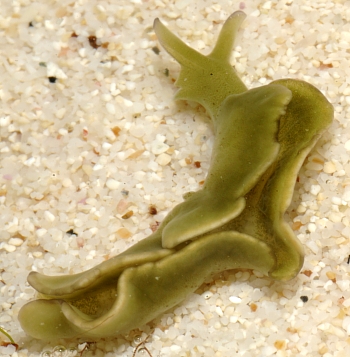
Does anyone recognise this?
Locality: Silhouette Is, Intertidal, Seychelles, Indian Ocean, August 2007, rock and sand. Length: ~1 cm. Photographer: Richard Barnes.
Richard Barnes
dkab@bas.ac.uk
Barnes D.K.A., 2007 (Aug 27) Elysia sp. from the Seychelles. [Message in] Sea Slug Forum. Australian Museum, Sydney. Available from http://www.seaslugforum.net/find/20538Dear Dave,
This is a species of Elysia, but I do not recognise the species. Hopefully Kathe Jensen, or someone else experienced in these sacoglossans can help
Best wishes,
Bill Rudman
Glaucid sp. from NE Bali, Indonesia
July 12, 2007
From: Lindsay Warren
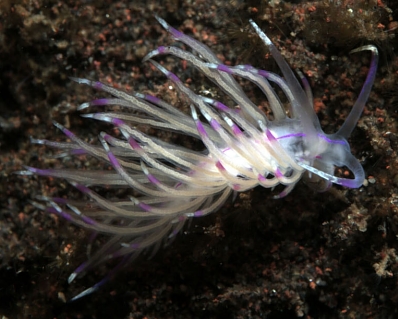
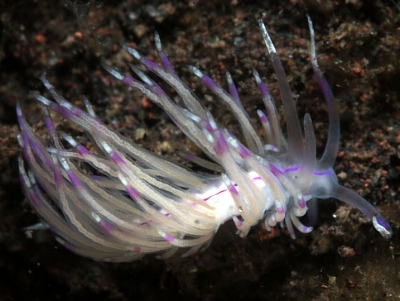
Dear Bill
While doing a night shore dive off Bali in May last year, I found this specimen which I have not yet been able to identify. Initially I thought it might be a species of Flabellina but on closer inspection can see that, for a start, the rhinophores are completely smooth whereas I believe Flabellina are not. Then Phyllodesmium crossed my mind but I have still had no luck in identifying it. I wonder whether you might be able to shed some light. Is it a type of Glaucid?
Locality: House Reef, Scuba Seraya, Tukad Dabu, not recorded, NE Bali, Indonesia, Tropical Western Pacific, 8 May 2006, Open black sand slope, close to shore but not intertidal, close to low growing reef area. Length: 10 mm. Photographer: Adam Powell.
In one photo one can see some hydroid / anemone type organisms which might be its food but I didn't see it directly feeding on them.
Many thanks for your help.
All the best
Lindsay
lwarren@datonomy.co.uk
Warren, L.C.R., 2007 (Jul 12) Glaucid sp. from NE Bali, Indonesia. [Message in] Sea Slug Forum. Australian Museum, Sydney. Available from http://www.seaslugforum.net/find/19179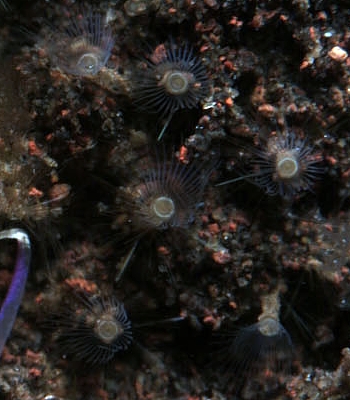
Dear Lindsay,
It could be a Flabellina, there are some with smooth rhinophores, but my feeling is that it is a glaucid, perhaps a species of Sakuraeolis. But until someone has a look at its anatomy we can't really say. The purple line median line and the ceratal colour seem quite distinctive but I can't recall a named species with this colour pattern.
The hydroid-like organism is almost certainly a polychaete tube worm.
Best wishes,
Bill Rudman
An Aeolid from the Gulf of Oman
July 5, 2007
From: Dragan Petkovic
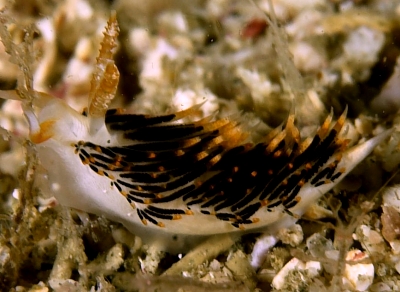
Dear Bill,
Attached is the cropped image of an aeolid nudibranch spotted on sand in Khor Fakkan, UAE. Could you please help with the identification?
Locality: Khor Fakkan, 23 m, United Arab Emirates, Indian Ocean, Gulf of Oman, 28 February 2007, Sandy. Length: ~ 1 cm. Photographer: Dragan Petkovic.
Dragan Petkovic
machodiver@gmail.com
Petkovic, D., 2007 (Jul 5) An Aeolid from the Gulf of Oman. [Message in] Sea Slug Forum. Australian Museum, Sydney. Available from http://www.seaslugforum.net/find/19580Dear Dragan,
I'm afraid I can't see enough of this aeolid nudibranch to see if the colour pattern is distinctive. The rhinophores have very distinctive rings, which suggests that this is possibly a species of Facelina, Phidiana or one of their relatives, but I can't say much else.
Best wishes,
Bill Rudman
Phyllodesmium sp? from Lembeh Strait
February 17, 2007
From: Mike Krampf
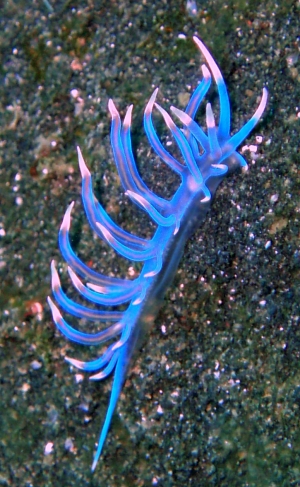
Dear Bill,
The only thing that I've been able to find that is close to this one is an unidentified Phyllodesmium sp. Your thoughts?
As you can see from the photo, I found him just crawling across the sandy bottom in Lembeh.
Locality: Lembeh Strait, 45 ft, Indonesia, Celebes Sea, 28 October 2006, Sandy bottom. Length: 3 cm. Photographer: Mike Krampf.
Mike
mtkrampf@yahoo.com
Krampf, M., 2007 (Feb 17) Phyllodesmium sp? from Lembeh Strait. [Message in] Sea Slug Forum. Australian Museum, Sydney. Available from http://www.seaslugforum.net/find/18875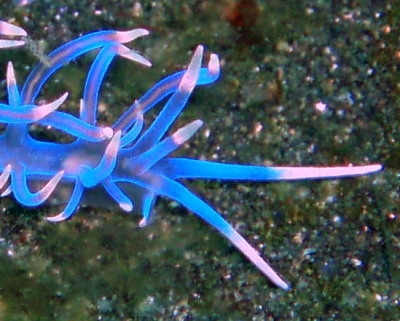
Dear Mike,
I think I would suspect a species of Phyllodesmium, but I don't recognise it and I suspect we would need to examine its anatomy to be sure.
Best wishes,
Bill Rudman
Master of camouflage - unknown aeolid
January 4, 2007
From: Erwin Kodiat
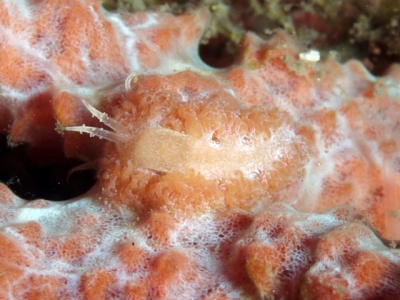
Hi Bill,
This one was spotted by a friend and it was so difficult to photograph due to its shape and color so blended into the hard coral it stands. Can you help me ID this?
Locality: Lembeh Strait, 7 metres, North Sulawesi, Indonesia, Lembeh Strait, 23 October 2006. Length: 2 cm. Photographer: Erwin Kodiat.
Erwin Kodiat
ungu@terong.com
Kodiat, E., 2007 (Jan 4) Master of camouflage - unknown aeolid. [Message in] Sea Slug Forum. Australian Museum, Sydney. Available from http://www.seaslugforum.net/find/18937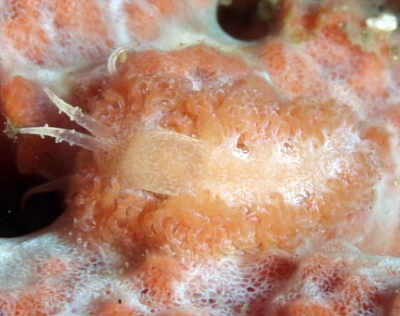
Dear Erwin,
This aeolid has a shape and colour to render it almost invisible on this sponge colony. Although in shape it looks quite like a tritoniid, its rhinophores are not those of a tritoniid, but almost certainly those of an aeolid. Which raises the question of why an aeolid, which don't feed on sponges, is camouflaged to live on a sponge? Perhaps the sponge-like colony is not a sponge, but it doesn't look like a cnidarian colony either, which are the usual food of aeolids. There is a strange cuthonid, Cuthona kuiteri, which is also found on particular sponges, but it is camouflaged to look like its food, which is a solitary tubularian hydroid which lives in association with the sponge. Possibly this aeolid of yours feeds on a hydroid with a similar relationship to the sponge. If so, this is a very complex inter-relationship between three animals.
Unfortunately all I can make at this stage is guesses - but it certainly is an animal worth looking for again. If you find iy again on the same sponge, then you should look for hydroids or some other cnidarian associate of the sponge, which it could be eating.
Very interesting,
Bill Rudman
Chromodorid from Indonesia
December 21, 2006
From: Ann Clear
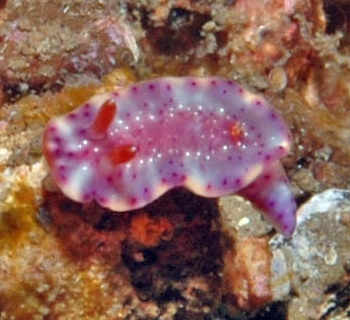
Hi Bill,
We have just returned from diving in the wonderful Lembeh Straits. I spotted this little fellow, but it was tucked away in a rocky outcrop, which was difficult to get to, therefore the photo is not the best. Can you help please, we thought it may be a juvenille Mexichromis macropus?
Locality: Lembeh Strait, 15 m, Indonesia, Molucca Sea, 15 October 2006, Rocky outcrop on reef. Length: 1 cm. Photographer: Ann Clear.
Thank you
Regards
Ann Clear
ann.clear@btinternet.com
Clear, A, 2006 (Dec 21) Chromodorid from Indonesia. [Message in] Sea Slug Forum. Australian Museum, Sydney. Available from http://www.seaslugforum.net/find/18969Dear Ann,
I'm afraid this is another mystery. It certainly looks like a chromodorid but I would think it was probably a Hypselodoris rather than a Mexichromis.
Best wishes,
Bill Rudman
Unknown nembrothid from Indonesia
December 20, 2006
From: Ann Clear
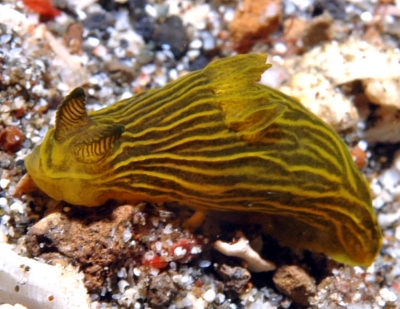
Hi Bill,
We have just returned from the wonderful Lembeh Strait and of course saw many different Nudibranchs, which we have been able to identify. However we can find no photo or description of the attached species. Can you please help.
Locality: Lembeh Strait, 10 meters, Indonesia, Banda Sea, 10 October 2006, Sandy bottom. Length: 1cm. Photographer: Ann Clear.
Thank you
Regards
Ann Clear
ann.clear@btinternet.com
Clear. A, 2006 (Dec 20) Unknown nembrothid from Indonesia. [Message in] Sea Slug Forum. Australian Museum, Sydney. Available from http://www.seaslugforum.net/find/18968Dear Ann,
This is a nembrothid, probably a species of Tambja or perhaps Nembrotha. It is possibly a juvenile. I am afraid I don't recognise it, but hopefully someone may be able to help
Best wishes,
Bill Rudman
Re: Mystery from the Philippines - final word
December 13, 2006
From: Scott Johnson
Concerning message #19000:
Hi Bill,
As you say, we will never know (concerning message #18976) but my first thought was a chunk of "mobile" Sarcophyton. I have seen chunks about that size and not much different in shape being carried around by the sponge crab Cryptodromiopsis plumosa. Although they usually carry sponges, I have seen them with soft corals, tunicates, and once even a clump of zoanthids. You often cannot tell from above that the crab is under there.
It's just a guess. And we're getting off topic. But it's fun to speculate.
Scott
uwkwaj@yahoo.com
Johnson, S., 2006 (Dec 13) Re: Mystery from the Philippines - final word. [Message in] Sea Slug Forum. Australian Museum, Sydney. Available from http://www.seaslugforum.net/find/19015Thanks Scott,
And thanks to the other 10 or so people who have sent messages which I wont post - sorry but as Scott says we are getting off topic. I wish on topic sea slug messages would generate as much to and fro I guess we all like a bone to gnaw on now and then.
Best wishes,
Bill Rudman
Re: Mystery from the Philippines
December 12, 2006
From: Philip Cromwell
Concerning message #18976:
Dear Bill, Gaetan, and Lara,
To me this looks like a soft coral (Sarcophyton sp.) with all of its polyps retracted.
Regards,
Phil
chiron42@sbcglobal.net
Cromwell, P.A., 2006 (Dec 12) Re: Mystery from the Philippines. [Message in] Sea Slug Forum. Australian Museum, Sydney. Available from http://www.seaslugforum.net/find/19000Thanks Phil,
A soft coral was also one of my thoughts, but from Gaetan's comment that it was gone the next time he dived there, I assumed it was capable of movement. I am afraid that unless someone can extract DNA from photos we will never be sure
Best wishes,
Bill Rudman
Mystery from the Philippines
December 12, 2006
From: Lara Henry
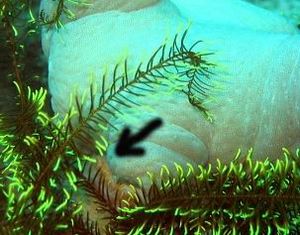
Concerning message #18954:
The first thing that came to my mind was sea star, as well. If you look at the second photo, the arm pointing towards the camera is rotated slightly, so that you can see the underside. There appears to be an ambulacral groove (where a sea star's tube feet protrude).
Lara Henry
University of South Florida
College of Marine Science
St. Petersburg, FL
lhenry@marine.usf.edu
Henry, L.V., 2006 (Dec 12) Mystery from the Philippines. [Message in] Sea Slug Forum. Australian Museum, Sydney. Available from http://www.seaslugforum.net/find/18976
Dear Lara,
Thanks for your comments. Unfortunately the original photo was a bit large to post, but here is a section showing the 'tube feet' looking objects at higher magnification.They are part of the crinoid. Like you and Dave, I had thought starfish, but I don't think we can ever know.
Best wishes,
Bill Rudman
Mystery from the Philippines
December 8, 2006
From: Gaetan White
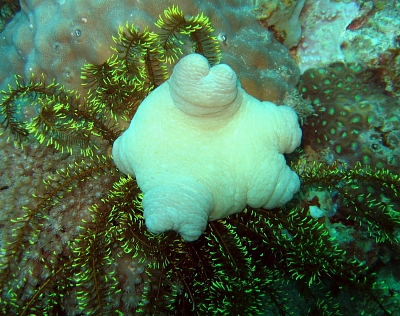
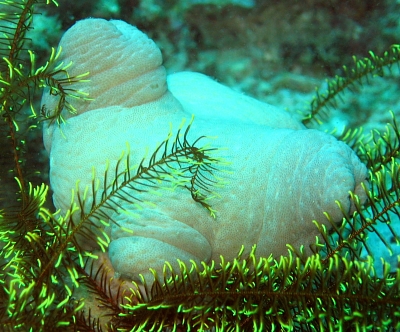
Dear sirs,
I try not to touch or displace anything in the sea so this creature 12 to 15 cm diameter, was in situ when the pics were taken, (beginning of slack). I went back including night dives and didn't find it again unfortunately. These were taken on Siquijor, Philippines. on 3/3/2005, in the comparatively weather-protected bay off KIWI dive resort, at "Paquit point" drop-off, vis 5-10 m between 10-15 meters depth, during slightly heavy seas. It was near the edge of the coral overhang behind which is the sand bottomed coral plateau. The area has heavy tidal currents sweeping in a constant direction. It did not have an attached stem and had maybe just arrived with the crinoid Comaster multifidus (One of many arriving with the current.)
I have asked many diver-travellers and institutes what it is, but as yet have not received a reply. I wondered if it was a velutinid [Coriocella or Chelynotus spp]
Locality: Siquijor, 10 m, Philippines, Bohol sea, 3-3-2005, see text. Length: 12 cm. Photographer: Gaetan White.
Considering its one of the few creatures I have not managed to name in my personal photo identification collection, mainly of sea, aquatic species, (Nudis. Syngna. Eels. Snakes. ETC) taken in Phil, but also Mal. Indo. Thai. Viet. Lao. (some copied from Net because of exceptional interest, or because i've seen them, but not been able to take pics, (no or drowned cameras)), I would greatly appreciate knowing what it is. As yet no institutes have replied, but i can't tell if its because its a common creature and they can't be bothered to reply, or if they don't know!
Thanks for your reply.
Gaetan White
gaetan.white@wanadoo.fr
White, G.A., 2006 (Dec 8) Mystery from the Philippines. [Message in] Sea Slug Forum. Australian Museum, Sydney. Available from http://www.seaslugforum.net/find/18954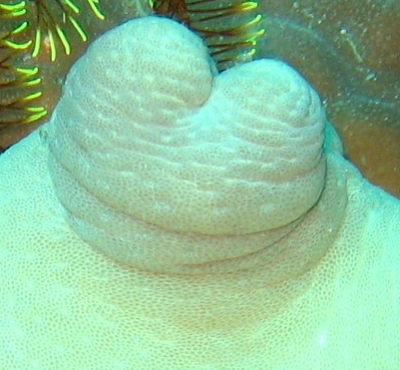
Dear Gaetan,
Thank you for the very beautiful and interesting submission. I can understand why none of the institutions you contacted have replied. I am afraid that without a peek at the underside of this creature we can only speculate. At this point I am not even sure it is a mollusc. Because of the radial symmetry and the leather like appearance of the "skin", I suspect that you have some kind of seastar. Whether juvenile or adult, is uncertain.
What this animal is doing on a crinoid is also problematic. Neither molluscs nor other echinoderms are known to hang out on feather stars. We would really need to get a look at its underside to determine if it has tube feet or a mollusc like foot. Sorry we are not of much help.
Keep up the good work,
Dave Behrens
Rostanga from Sri Lanka
March 12, 2005
From: Marina Poddubetskaia
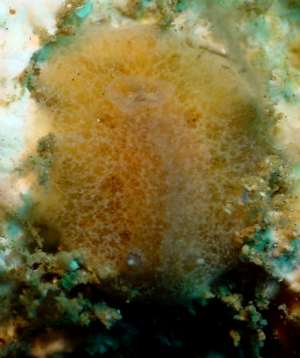
Dear Bill,
Several months ago, when I dived in Sri Lanka, I found a kind of Rostanga: 2 animals under a stone 'asleep' near several egg-ribbons which looked all the same. Please, could you help me to identify this species ? My only guess would be Rostanga lutescens, but I'm not sure.
Locality: 'Goda Gala Diyamba', Unawatuna. Sri Lanka, Indian Ocean. Depth: 13 m. Length: Upper right: 15mm. Lower left: 16mm. Egg ribbon diameter: Upper: 8mm. Lower: 12mm. 08 November 2004. sandy, under stone. Photos: Marina Poddubetskaia - Nembro website
Thank you in advance for your help.
Cheers,
Marina.
nembro@nembro.info
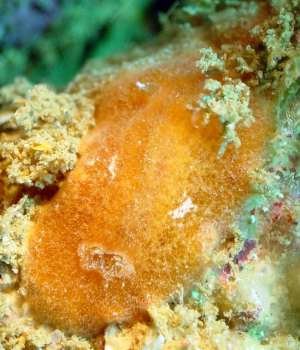
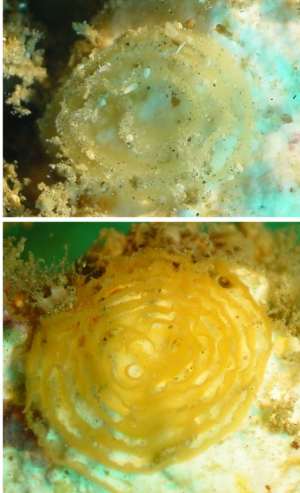
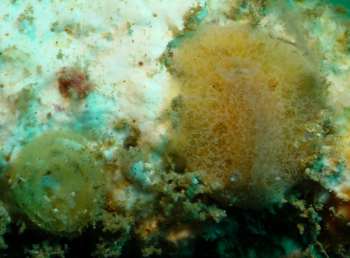
Dear Marina,
I suspect you are right to associate these animals with the egg masses. Concerning what theya are is a little more difficult. They could either be a species of Jorunna or a species of Rostanga, both genera being characterised by the 'furry' mantle caused by the dense covering of caryophyllidia. I lean towards Jorunna because there seem to be only a few gills (5-6), but I am afraid that without dissection it is not possible to be sure.
Best wishes,
Bill Rudman
Nembrotha from Malaysia
February 26, 2004
From: Isabelle Drouet
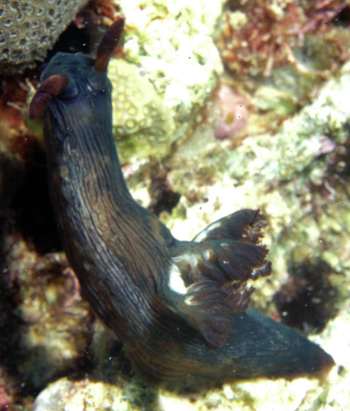
Dear Bill,
Can you identify this nudibranch? Is it Nembrotha lineolata?
This image was taken in Sipadan, Malaysia in April 2000.
Thanks
Isabelle Drouet
ijdrouet@free.fr
Drouet, I., 2004 (Feb 26) Nembrotha from Malaysia. [Message in] Sea Slug Forum. Australian Museum, Sydney. Available from http://www.seaslugforum.net/find/12311Dear Isabelle,
I am not sure if the lines on its body are true pigmented lines are darker creases or grooves in the skin. Both are found in diferenet species of Nembrotha. I may be wrong but I think this is an aberrant colour form of a usually more colourful species, but I can't say which one.
Best wishes
Bill Rudman
Favorinus? from sth Queensland
February 11, 2004
From: Gary Cobb
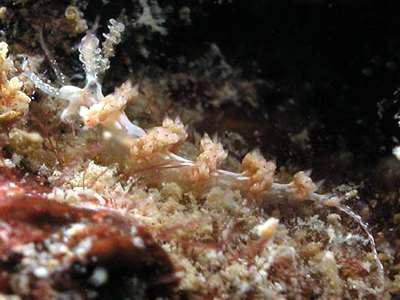
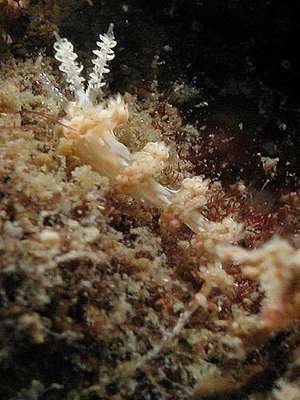
Hi Bill!
While diving at Old Woman Island at the Wall off Mooloolaba, Queensland, Australia in 9m of water I spotted this small animal, could it be a Favorinus of some sort? It was about 10mm long. It has rhinophores or tenacles that remind me of the Jetsons! Do these kind have any real purpose? It is quite an extraordinary animal that I can not ID ... have you seen this one before?
Thanks
Gary Cobb
gary@cobb.com.au
Cobb, G., 2004 (Feb 11) Favorinus? from sth Queensland. [Message in] Sea Slug Forum. Australian Museum, Sydney. Available from http://www.seaslugforum.net/find/12110Dear Gary,
I suspect I have forgotten quite a lot of what I've seen, but I can't recall one like this. I can't be sure, but I suspect this is likely to be a species of Flabellina. I have no idea why some species have developed such elaborate rhinophores. Since they can't see very well, and are hermaphrodite, we can rule out sexual selection, so perhaps it gives them an edge in sensing chemicals in the water, and finding their prey.
Best wishes
Bill Rudman
Unknown Nudi found in the Red Sea
February 4, 2003
From: Jason Bell
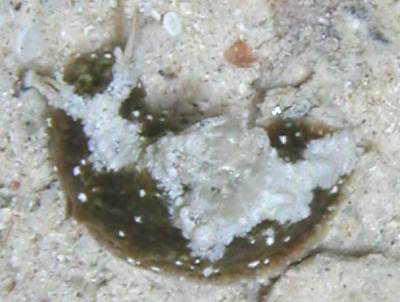
Dear Bill,
I found this green and white nudi. on two consecutive nights in Dahab, Egypt. It was found by my wife Nov. 25th at a depth of 13m. It was discovered on the same rock on the following night.
After downloading the pics, I notice on the first photo their was 3 juveniles located just above the adult with the same color patterns.
Thanks
Jason
belljason@hotmail.com
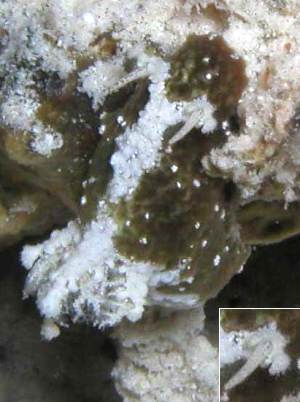
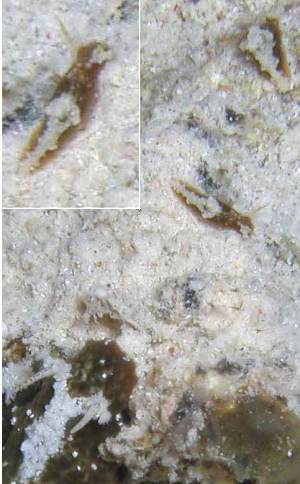
Dear Jason,
It looks like a Polycera but the tubercles on the rhinophore pockets look like it could be a species of Aegires. Which means I don't know what it is. Hopefully someone will recognise it as it has a very distinctve colour pattern.
Best wishes,
Bill Rudman
Hoplodoris? from Egyptian Red Sea
January 31, 2003
From: Jason Bell
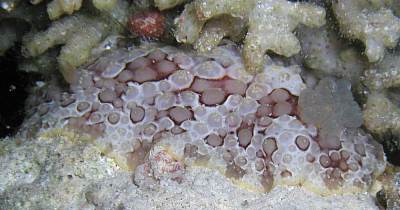
Dear Bill,
My wife found these 2 nudis on Nov 25th in Dahab, Eygpt. It was found at 13m on the same rock on two consecutive nights.
The 1st photo I believe is male and 2nd is the female on its way to lay the egg ribbon which is in the 3rd photo. Unfortunately, I did not see the nudi lay the eggs.
Thanks
Jason
belljason@hotmail.com
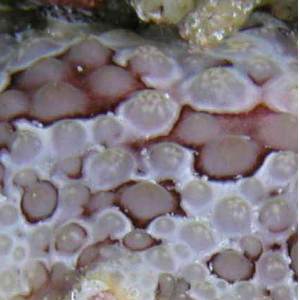
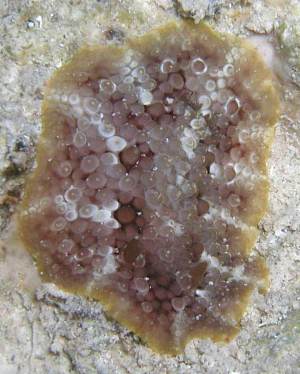
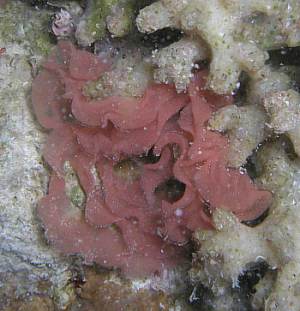
Dear Jason,
I am pretty sure this is a species of Hoplodoris but I will see if anyone else can suggest a species name for it. Concerning eggs and mating. All sea slugs are hermaphrodite and usually act as males and females simultaneously when mating. It is also very unsafe to assume they are the parents of the egg mass unless you catch them in the act of egg-laying. Nudibranchs don't usually 'brood' or protect their eggs, so proximity to an egg mass is not safe evidence of 'ownership'.
Best wishes,
Bill Rudman
Phyllidiella zeylanica? from Indian Ocean
November 16, 2002
From: Marina Poddubetskaia
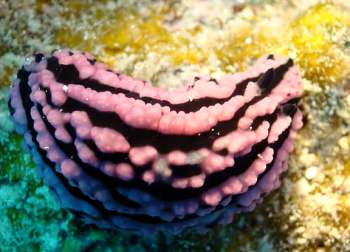
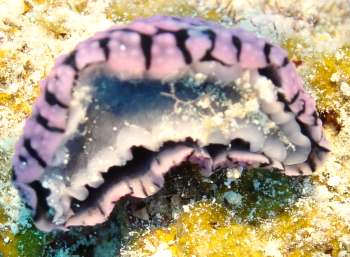
Dear Bill,
Concerning your comment in my earlier P. rosans message. Here is another animal which looks like the one in the lower left photo. Is it more like Phyllidiella zeylanica? The ventral view isn’t very good, but the yellow-green sponge (which can be seen on the most of my phyllidids photos) can be seen better. The white powder above is just the sand.
Date: October 16, 2002
Location: Pereybere, Mauritius, Indian Ocean
Site: Grand Aquarium
Depth: 10m
Size: 45-50mm
As for the localities ‘L’aquarium de Pereybere’ and ‘Grand Aquarium’, they are really diving sites. The specificity of these sites is that they are very rich in fauna : a lot of corals, invertebrates, fishes, etc. I dived a lot in ‘L’aquarium de Pereybere’ and each time I discovered something new. These both sites could be compared to an oasis. But it isn’t so for the ‘L’aquarium de Merville’ which is quite poor...
Best wishes,
Marina.
nembro@nembro.info
Poddubetskaia , M., 2002 (Nov 16) Phyllidiella zeylanica? from Indian Ocean. [Message in] Sea Slug Forum. Australian Museum, Sydney. Available from http://www.seaslugforum.net/find/8390Thanks Marina,
On reflection I don't think this is what I would call Phyllidiella zeylanica. The ventral view showing the black lines running out to the mantle edge are not usually found in that species. I think I will have to admit defeat with this one. If anyone can help out with a name I would be grateful
Best wishes,
Bill Rudman
Aeolid from Thailand
October 23, 2002
From: Erwin Koehler
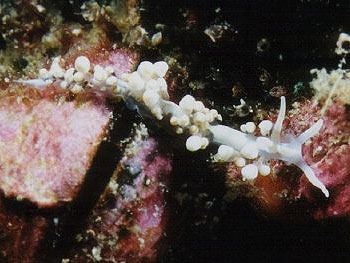
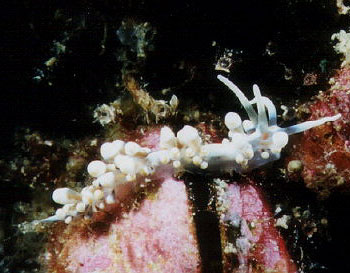
Dear Bill,
Here is an aeolid from Thailand, Koh Ha Yai,
depth 12m, sizes 19 mm, date Dec. 27, 2000. Can you help with an ID?
Erwin
Erwin@medslugs.de
Koehler, E., 2002 (Oct 23) Aeolid from Thailand. [Message in] Sea Slug Forum. Australian Museum, Sydney. Available from http://www.seaslugforum.net/find/3836Dear Erwin,
I'm afraid don't recognise this at all. I am even reluctant to suggest a family, although it could possibly be a species of Flabellina.
Best wishes,
Bill Rudman
Elysiids from Indonesia
October 21, 2002
From: Erwin Koehler
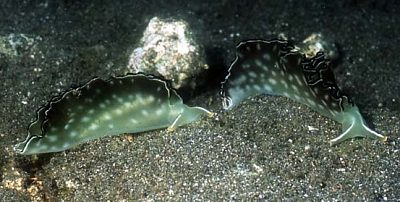
Dear Bill,
Attached are 3 shots of 4 specimens from Indonesia, Bali Island, July 2002, depth 9m
by Frank Gloystein [Email: frank@gloystein.de]. Can you help with an ID please?
Upper Right: 2 specimens about 4cm, Lower Left: approx 1cm long, Lower Right: approx 3cm long.
I think they are the same as #547 in Coral Reef Animals of the Indo-Pacific by Gosliner, Behrens & Williams (1996)(by the way, one of my favorite books). Can you confirm this ID? Has it been named meanwhile?
Erwin
Erwin@medslugs.de
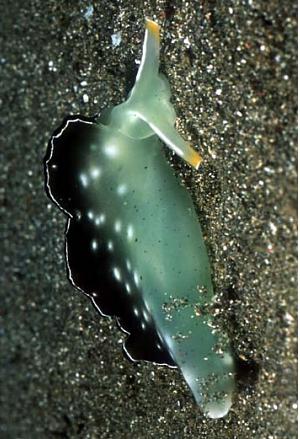
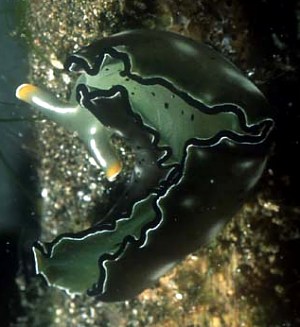
Thanks Erwin,
It is the animal you refer to in Gosliner, Behrens & Williams. The large thin parapodia are certainly reminiscent of Elysia ornata, but the colour doesn't seem right. Perhaps Kathe Jensen can help us.
Cheers,
Bill Rudman
An unknown aeolid from Bali
October 3, 2002
From: Rika Nozoe
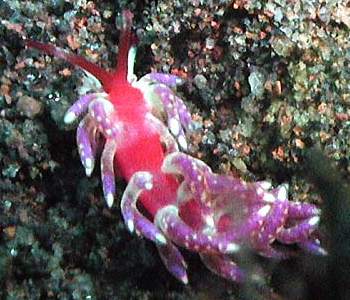
Dear Bill
How do you do. Could you help me identify this aeolid please. It is from Bali, Indonesia. Depth 5-8m
Rika Nozoe
cheki@ma5.justnet.ne.jp
Nozoe, R, 2002 (Oct 3) An unknown aeolid from Bali. [Message in] Sea Slug Forum. Australian Museum, Sydney. Available from http://www.seaslugforum.net/find/8056Dear Rika,
I am not sure what family this aeolid belongs to. It is possibly a tergipedid, perhaps Cuthona, but it is not possible to be sure without looking at its anatomy.
Best wishes,
Bill Rudman
Re: Elysiid from the Red Sea
October 3, 2002
From: Erwin Köhler
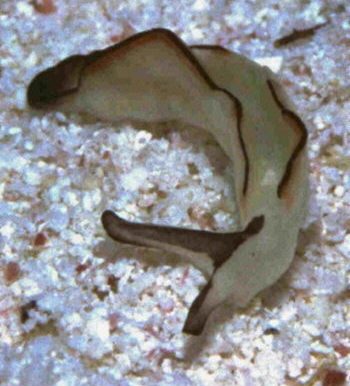
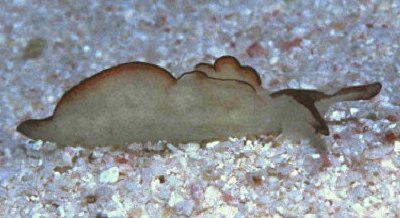
Dear Bill,
Concerning your comments about this animal. Some time ago Fred had to undergo an operation. Now he's getting better. Here are the same shots again, still with a little blue cast. I don't think it is a juvenile Elysia ornata because of the black Y on the head and the upper part of the rhinopores and it's size (2cm). The general colour is beige with a little greenish touch. As you suspected the border is black with an orange line inside.
Erwin
Erwin@medslugs.de
Köhler, E., 2002 (Oct 3) Re: Elysiid from the Red Sea. [Message in] Sea Slug Forum. Australian Museum, Sydney. Available from http://www.seaslugforum.net/find/7785Thanks Erwin,
It certainly clarifies the colours but I still don't recognise it
Cheers,
Bill Rudman
Phyllidia melanocera? from Egypt (2)
September 30, 2002
From: Michael Mrutzek
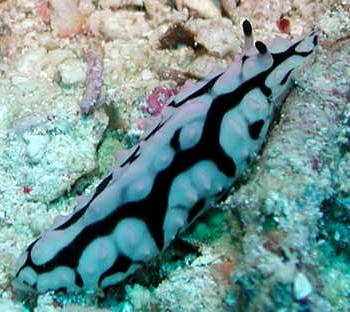
Dear Bill,
here is a photo of another slug from the Red Sea for use in the Forum.
Data: Giftun Soraya, 30 Meters, off Hurghada, on the Red Sea coast of Egypt, August, 2002. Photo: Copyright Michael Mrutzek.
Michael
Mrutzek@meeresaquaristik.de
Mrutzek, M., 2002 (Sep 30) Phyllidia melanocera? from Egypt (2). [Message in] Sea Slug Forum. Australian Museum, Sydney. Available from http://www.seaslugforum.net/find/8030This seems to fit Yonow's description of Phyllidia melanocera very well. Much better than the photo in your earlier message. Does anyone have any views on this?
Bill Rudman
Phyllidia melanocera? from Red Sea
September 28, 2002
From: Michael Mrutzek
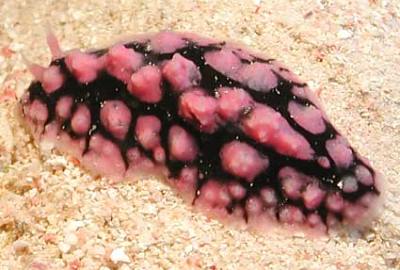
Dear Bill,
here is a photo of another slug from the Red Sea for use in the Forum.
Data: Abu Haschich Nord, 3 meters, off Hurghada, on the Red Sea coast of Egypt, August, 2002. Photo: Copyright Michael Mrutzek.
Michael
Mrutzek@meeresaquaristik.de
Mrutzek, M., 2002 (Sep 28) Phyllidia melanocera? from Red Sea. [Message in] Sea Slug Forum. Australian Museum, Sydney. Available from http://www.seaslugforum.net/find/8031Dear Michael,
Thanks for this interestng photo - although it has caused me considerable pain in trying to identify it. At this stage I must admit failure. It has similarities to Phyllidia melanocera Yonow, 1986, but has pink rhinophores rather than black and white. Also in Brunckhorst's revision of the family he considered Phyllidia melanocera to be a synonym of the widespread Phyllidiella pustulosa. If anyone has thoughts about this species they would be gratefully received.
Best wishes,
Bill Rudman
Need help identifying
September 18, 2002
From: Sabine Noack
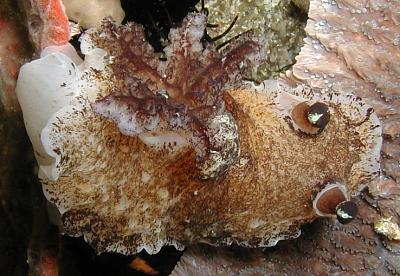
Hi,
I found this nudibranch in a depth of 18m near the island of Pulau Pisan in Horseshoe Bay (between Rinca and Nusa Kode), Nusa tenggara, Indonesia. September 2001.
It was 12 cm long.
Could this be a Jorunna or Kentrodoris?
Sabine
dive@snoack.de
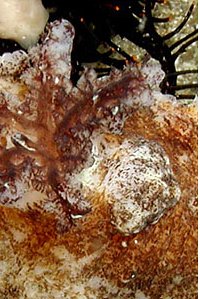
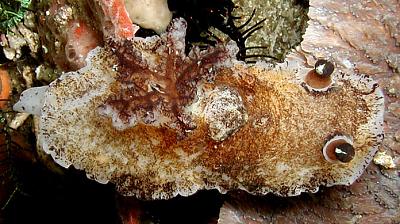
Dear Sabine,
I first thought this was Platydoris scabra but it appears to have a large protuberance in front of the gills. Does anyone recognise this animal?
Bill Rudman
Dermatobranchus from aquarium
September 18, 2002
From: Christel Theate
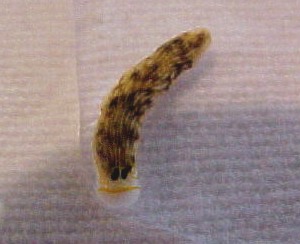
Hello,
I'm from Belgium and I've found this animal in my reef aquarium. Could you please help me to find a name??
Thank you.
Christel.
christeltheate@hotmail.com
Theate, C., 2002 (Sep 18) Dermatobranchus from aquarium. [Message in] Sea Slug Forum. Australian Museum, Sydney. Available from http://www.seaslugforum.net/find/7873Dear Christel,
All I can say is that it is a species of Dermatobranchus [Family Arminidae]. There are many species of this genus, many of which are unnamed, and almost all seem to feed on softcorals. I suspect yours 'hitchhiked' into your aquarium on some softcoral. If you have a look at the species listed under the Family Arminidae in the Species List you will get some background information on this group.
Best wishes,
Bill Rudman
Aeolid from the Philippines
July 30, 2002
From: Erwin Köhler
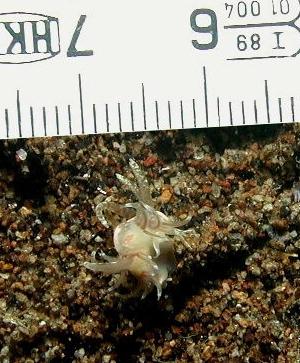
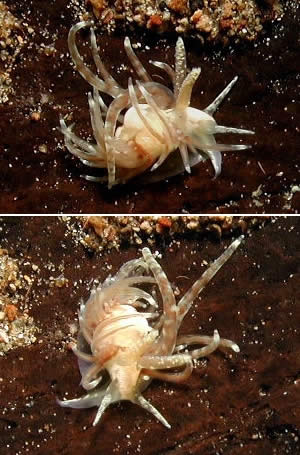
Dear Bill,
Here are some shots from the Philippines, Negros Oriental Island, divesite "Dauin", March 2002,
size 7-8mm, depth 16m.
Can you help with an ID?
Cheers,
Erwin
Erwin@medslugs.de
Köhler, E., 2002 (Jul 30) Aeolid from the Philippines. [Message in] Sea Slug Forum. Australian Museum, Sydney. Available from http://www.seaslugforum.net/find/7537Dear Erwin,
Sorry, I wouldn't like to guess at a family - but perhaps Aeolidiidae.
Cheers,
Bill Rudman
Eolid from Enewetak, Marshall Islands
July 18, 2002
From: Scott Johnson
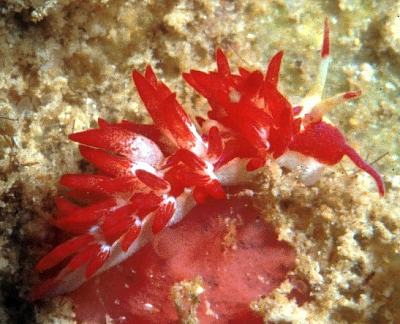
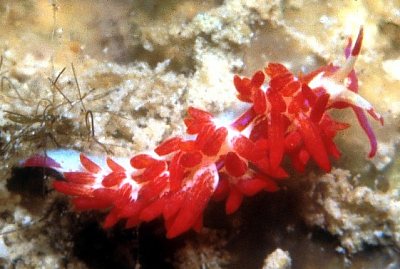
Hi Bill,
Here is a striking animal I've so far seen only once. It was found at a depth of about 1 meter on pier pilings at Enewetak Atoll in November, 1981. It measured 7mm. [e128] The bright red cerata hide much of the body coloration. The body had wide red longitudinal bands along each side just below the insertion points of the cerata. There was another red band middorsally that narrowed between cerata bunches. The dorsal red band contained purple patches. The top of the head was more magenta with a yellowish white anterior margin and patches of the same around the rhinophore bases.
Scott Johnson
johnson@kmr.ll.mit.edu
Johnson, S., 2002 (Jul 18) Eolid from Enewetak, Marshall Islands. [Message in] Sea Slug Forum. Australian Museum, Sydney. Available from http://www.seaslugforum.net/find/7433Thanks Scott,
Certainly is spectacular enough to be recognised if it has a name
Cheers,
Bill Rudman
Strange dorid from Hachijo Island, Japan
May 3, 2002
From: Shouichi Kato
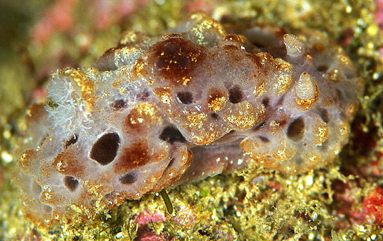
Dear Bill,
I guess this is a dorid but I don't I have any idea about its family, or name. I found it under rocks. It looked very soft like a sponge but when I felt it it was hard.
I would very appreciate your help.
Data : under the rock, Hachijo Island, Japan. Depth: 5m, length: 30mm
Regards,
S. Kato
regulus@edit.ne.jp
Kato, S., 2002 (May 3) Strange dorid from Hachijo Island, Japan. [Message in] Sea Slug Forum. Australian Museum, Sydney. Available from http://www.seaslugforum.net/find/6518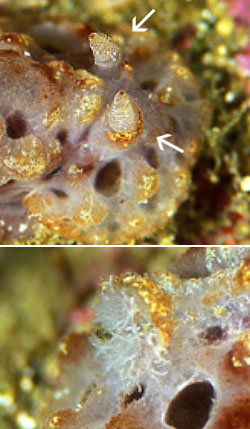
Dear Shouichi,
I have included close-ups of the gills and rhinophores alongside just so we can see it is a dorid and not a lump of sponge or soft coral. On first look I thought it might be Actinocyclus japonica but the gills look quite different and the skin seems to have a network of spicules rather than the smooth leathery nature of Actinocyclus. One genus which does often mimic sponges like this is Trippa but if so I don't recognise it.
Best wishes,
Bill Rudman
Cephalaspidean from the Philippines
May 3, 2002
From: Erwin Köhler
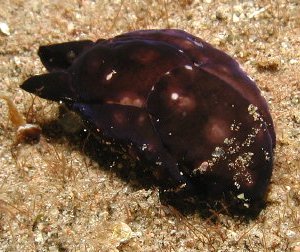
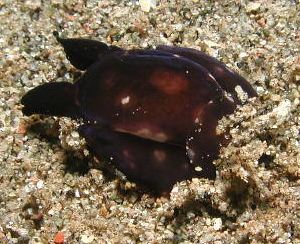
Dear Bill,
Here is the next one from the Philippines, Negros Oriental Island, Lipayo, divesite "Dauin", nightdive.
Size: 32mm
Depth: 15m
05.March 2002
Erwin
Erwin@medslugs.de
Köhler, E., 2002 (May 3) Cephalaspidean from the Philippines. [Message in] Sea Slug Forum. Australian Museum, Sydney. Available from http://www.seaslugforum.net/find/6576Dear Erwin,
It is most probably a species of Philinopsis but I'm afeaid I can't say much else. It coud possibly be a a very dark form of P. pilsbryi but that is only a guess.
Best wishes,
Bill Rudman
Another deepwater slug from Hawaii
May 2, 2002
From: Dr. Christopher Kelley
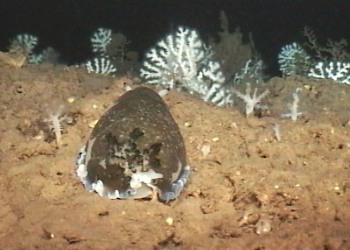
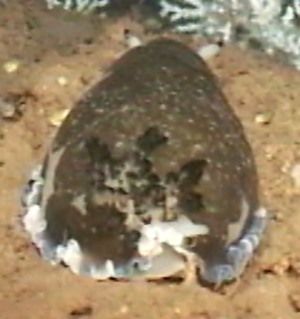
Hello everyone:
Following my first message, here is a photo of a second slug from deepwater off Hawaii. Cory Pittman has already suggested that this may be Dendrodoris or Bathydoris sp. (R-126-d2-n1)was videotaped on a hard carbonate substrate at 222 meters, also in the main Hawaiian Islands.
Thank you in advance for whatever help you can provide.
Dr. Christopher Kelley
ckelley@soest.hawaii.edu
Kelley, C., 2002 (May 2) Another deepwater slug from Hawaii. [Message in] Sea Slug Forum. Australian Museum, Sydney. Available from http://www.seaslugforum.net/find/6826Dear Chris,
My first thought would be a species of Dendrodoris. I think species of Bathydoris have many more gills than this and live in much deeper water - 1500 meters or more. Can you give me any indication of size? If it is a deep water representative of a shallow water species, the most likely candidates would be Dendrodoris fumata or Dendrodoris nigra. The general body shape looks more like D. nigra but the gills more like D. fumata.
Best wishes,
Bill Rudman
Aeolid from the Philippines (2)
April 30, 2002
From: Erwin Köhler
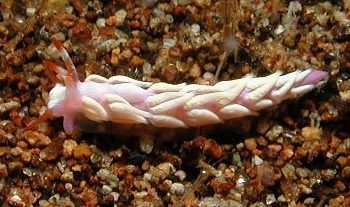
Dear Bill,
Here is another one from the Philippines, Negros Oriental Island, Lipayo, divesite
"Dauin".
There were six animals and they ranged in size between 7mm - 15mm, [upper right animal 13mm long]. Depth: 8m., Date: March 2002.
Erwin
Erwin@medslugs.de
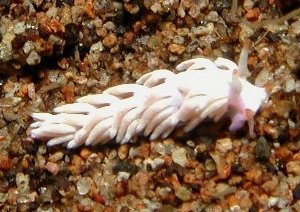
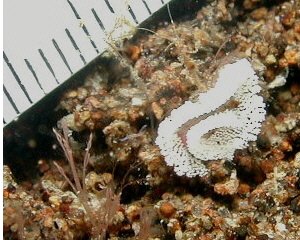
Dear Erwin,
My first thought would be a tergipedid, but the pointed anterior foot corners suggest it isn't. Apart from that I can't really say much without some anatomical information.
Best wishes,
Bill Rudman
Elysiid from the Red Sea
March 12, 2002
From: Erwin Köhler
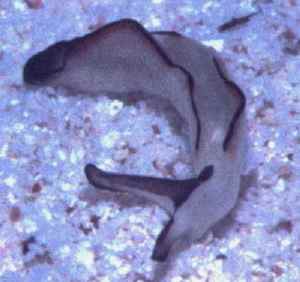
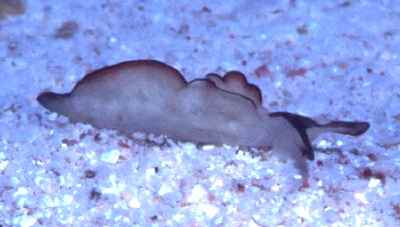
Dear Bill,
Attached are 2 shots by Fred Vogt
Email: reticulata@gmx.net
from the Red Sea, Egypt, Hamata. Size ~2 cm, Nov. 2001
Erwin
Erwin@medslugs.de
Köhler,E., 2002 (Mar 12) Elysiid from the Red Sea. [Message in] Sea Slug Forum. Australian Museum, Sydney. Available from http://www.seaslugforum.net/find/5852Thanks Erwin,
I suspect something is wrong with the colour of this image - the blue cast is unnatural. I suspect the colour of the animal is probably greenish with a black border and an orange or yellow band inside the black (where it appears red in lower photo). Perhaps its a juvenile of Elysia ornata - but that's very much a guess. Any other thoughts welcome.
Best wishes,
Bill Rudman.
Elysia from Queensland
February 24, 2002
From: Alison Smith
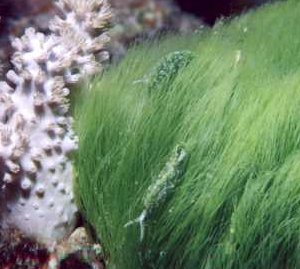
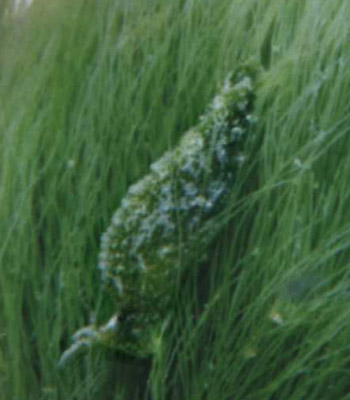
Hi there.
This photo was taken on a night dive (about 6.30pm)on the 19th January 2002 at Milne Reef, south east of Cairns [Queensland, Australia]. The depth was approx 10 metres.
I believe it is a form of Elysia, but cannot identify the exact type. Would you be able to help?
Thanks very much
Alison Smith
allyazza@ozemail.com.au
Smith, A., 2002 (Feb 24) Elysia from Queensland. [Message in] Sea Slug Forum. Australian Museum, Sydney. Available from http://www.seaslugforum.net/find/6173Dear Alison,
I agree that this is probably a species of Elysia but I am afraid I can't see enough detail in your photo to be sure. As you'll will see if you follow the correspondence on the Forum, these animals are quite difficult to identify even when we can see them clearly. If you get a chance to take some more photos send them in and we'll have another go at identifying it.
Best wishes,
Bill Rudman
Chromodorid 'conference' in Indonesia
December 22, 2001
From: Stuart Hutchison
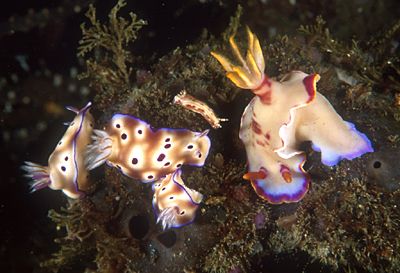
Hi Bill,
I absolutely promise we didn't move these guys together!! In fact there was another Hypselodoris maculosa nearby, but out of frame. The "Hypselodoris bullocki" seems pretty unusually coloured too. The H. maculosa [in middle]was about 20mm long, Risbecia tryoni [on left]between 30-50mm long and the "H. bullocki" [on right]around 70mm long. They were stationary at 40m depth, Oct 2001, Tulamben, Bali, Indonesia.
Regards,
Stuart
stuart@stuarthutchison.com.au
Hutchison,S., 2001 (Dec 22) Chromodorid 'conference' in Indonesia. [Message in] Sea Slug Forum. Australian Museum, Sydney. Available from http://www.seaslugforum.net/find/5683Dear Stuart,
Certainly a gathering of the clans. Perhaps they are all feeding on the same sponge. The Hypselodoris on the right certainly has the shape of H. bullocki but the relatively wide mantle skirt and multicoloured mantle border suggest it may be a distinct species. If you have any other photos of it, they would be welcome.
Best wishes,
Bill Rudman.
Unknown sponge feeder
October 2, 2001
From: Jim Cruise
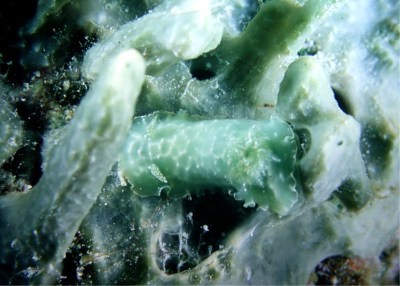
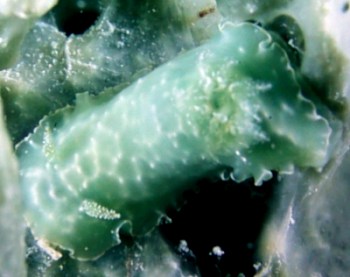
Dear Bill,
Please find attached a jpeg image of a small nudibranch I found a few years ago. I was unable to find out what it was back in 1992, and did not see it again until 1999, and again have not been able to identify it with any of the new reference books I have. Can you, or anyone reading the Forum shed any light on this for me please.
Photo in situ, Length 15 mm, depth 5 m, Location: Little Fairey Reef (Great Barrier Reef) South 19 33.167, East 148 56.006, 18 July 1992.
A further specimen was found 25 April 1999 at Kelso Reef, South 18 26.7 East 146 59.8, depth 9 m, size range 6-16 mm, same species of sponge.
Jim Cruise
jim.cruise@env.qld.gov.au
Cruise, J., 2001 (Oct 2) Unknown sponge feeder. [Message in] Sea Slug Forum. Australian Museum, Sydney. Available from http://www.seaslugforum.net/find/5347Dear Jim,
Sorry but I don't recognise it. I wonder how many more little cryptic species there are to be found. Hopefully someone will know its name, if it has one, or recognise it as something they have found as well.
Best wishes,
Bill Rudman
Flabellina from the Philippines
August 10, 2001
From: Erwin Köhler
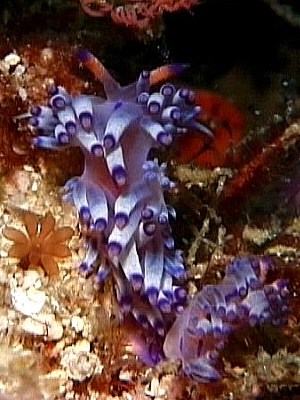
Dear Bill,
Here is another one from the Philippines by
Peter Schmutz peterschmutz@cs.com.
Other data were not recorded.
It is a shot from a video, so the quality is pretty poor. Can you help with an ID?
Erwin
Erwin@medslugs.de
Köhler, E., 2001 (Aug 10) Flabellina from the Philippines. [Message in] Sea Slug Forum. Australian Museum, Sydney. Available from http://www.seaslugforum.net/find/4901Dear Erwin,
I'm pretty sure it is a species of Flabellina but I don't recognise it. The only one with bluish rings is Flabellina riwo but I don't think it is a colour form of that species. The blue purple rings are too near the ceratal tip and the rhinophore clubes much thinner than in F. riwo.
Best wishes,
Bill Rudman.
Mystery nudibranch
May 14, 2001
From: Melanie
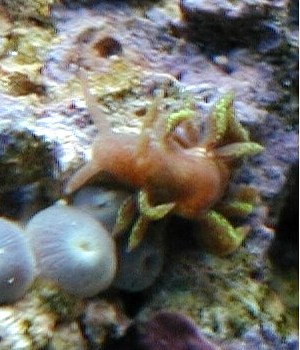
I found about 5 of these critters in my reef tank. They look like they may be babies and
have a light pink body with 10 to 12 iridescent spikes on top. Do you know if they are reef safe?
I have not bought any live rock for several months - but most of my live rock is from Fiji. I have several smaller ones also that dont have any color yet. I think they are breeding in my tank. But I don't know where they are coming from. I don't see any
large ones just tiny ones
Melanie
zildjian@northcoast.com
Melanie, 2001 (May 14) Mystery nudibranch. [Message in] Sea Slug Forum. Australian Museum, Sydney. Available from http://www.seaslugforum.net/find/4309Dear Melanie,
It certainly looks like this animal is breeding in your aquarium. It is an aeolid nudibranch. Aeolids feed on cnidarians (sea anemones, hydroids, corals, soft-corals) but each species feeds on only one or a few species of cnidarian. This animal must have arrived in your aquarium as a very small juvenile, probably on its prey, and been quietly nibbling away at something in your aquarium. If you are now seeing smaller uncoloured specimens I suspect that your aeolid is now into a second generation. The two most likely prey items that they are feeding on would be a soft-coral or a hard coral. If you have either, have a look for egg masses. They will either be a sausage-shaped, jelly-like sac containing lots of small white eggs, or else a spirally coiled ribbon. Have a look at the page on Coral-feeding nudibranchs for an idea of what you are looking for. It is possible that the eggs will be under the colony.
What should you do with them? My biased opinion would be to leave them and see what happens. Alternatively perhaps you can try and find what they are eating by looking for egg ribbons and more animals. Uusually they will be living on their food. If you do find some sign of them, have a look at what damage they are doing, and if it is not enormous perhaps you should just leave them be. The first step though is to see if you can discover what they are doing yourself. I suspect they are a coral feeder but they don't look like any species I am familiar with.
Best wishes,
Bill Rudman.
Yellow aeolid on hydroid
April 12, 2001
From: Tony Wu
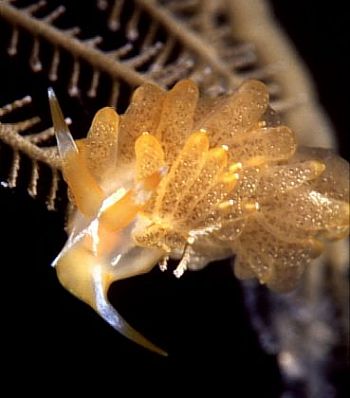
Hi Bill,
Here's another one for you. This was taken in Manado, Indonesia, not sure of the depth.
Tony Wu
osiris@singnet.com.sg
Wu, T., 2001 (Apr 12) Yellow aeolid on hydroid. [Message in] Sea Slug Forum. Australian Museum, Sydney. Available from http://www.seaslugforum.net/find/4111Dear Tony,
This is a species of aeolid, possibly a tergipedid or a eubranchid, but I don't recognise the colour pattern, and without a better idea of its external shape and internal anatomy I can't really say much more. It seems, from the photo, that the digestive gland in the cerata forms a branching network of ducts rather than a single medial duct. If that is so it is a most interesting feature found only in some species which have symbiotic plants in their bodies. [See Solar Powered Nudibranchs Page].
Best wishes,
Bill Rudman
Need help ID this nudibranch/slug
January 1, 2001
From: Planoi
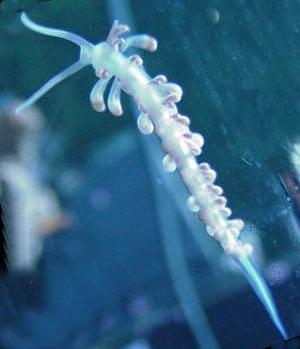
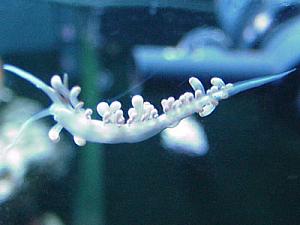
Would you help me identify this?
Is it Berghia nudibranch?
thanks,
Planoi
Bangkok, Thailand
winp@writeme.com
Planoi, 2001 (Jan 1) Need help ID this nudibranch/slug. [Message in] Sea Slug Forum. Australian Museum, Sydney. Available from http://www.seaslugforum.net/find/3416Dear Planoi,
It is not Berghia but it is an aeolid nudibranch. If you look in the Species List at some of the animals listed under SUBORDER AEOLIDINA you will see some of the variety in shape and colour amongst the aeolids.
It is difficult to identify these animals form a photograph taken of their foot. I really need to get a good look at then from above so I can see how their cerata are arranged and the shape of the rhinophores, as well as the general colour of the animal. I can therefore only make a guess at what your animal is. The only distinctive feature I can see is the purplish band on each ceras. One species that has such a band is Flabellina riwo but I can't be sure. all I can say is that it is an aeolid nudibranch.
Best wishes,
Bill Rudman
Need help ID an sea slug/nudibranch?
December 30, 2000
From: Win
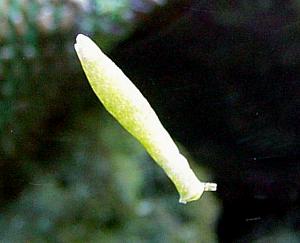
Hi, I found this in my aquarium. Can you please help me ID it? I am interested in knowing its diet and whether it is harmful to other fish or inverts.
I think it came with the rocks that I got from the east coast of Thailand.
Thanks.
Win
winp@writeme.com
Win, 2000 (Dec 30) Need help ID an sea slug/nudibranch?. [Message in] Sea Slug Forum. Australian Museum, Sydney. Available from http://www.seaslugforum.net/find/3291Dear Win,
It is a bit hard identifying this from a photo of its foot but I am pretty sure that it is a sacoglossan, most probably a species of Elysia. If you have a look at some of the species of Elysia in the Species List you will see there is quite a variety of species.
None of them are likely to harm anything in your aquarium. if they can find the right algae growing in your aquarium they should remain very happy.
Best wishes,
Bill Rudman
Elysia or Thuridilla from Coral Sea
October 22, 2000
From: Des Paroz
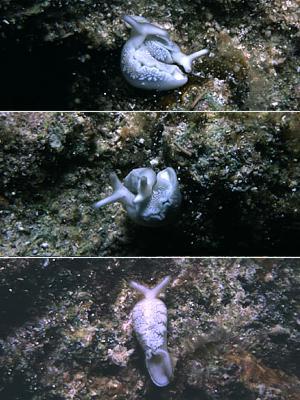
Hi Bill
Saw this one at a couple of dive sites on the recent Coral Sea trip. The bottom shot shows one found at Trigger Happy (Flinders Reef) in about 14m, and the two other shots were taken at Eel Gardens (also Flinders Reef) was in about 12m.
Once again, appreciate help in identifying it.
Best regards
Des Paroz
www.divesite.paroz.com
des@paroz.com
Paroz, D., 2000 (Oct 22) Elysia or Thuridilla from Coral Sea. [Message in] Sea Slug Forum. Australian Museum, Sydney. Available from http://www.seaslugforum.net/find/3151Dear Des,
It is a species of Elysia or Thuridilla but I am not sure if it has a name. I vaguely remember seeing a picture of it but can't find it. Hopefully Kathe Jensen can help us out.
Best wishes,
Bill Rudman.
What is this?
June 17, 2000
From: Mary Jane Adams
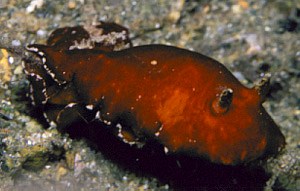
Dear Bill,
I found this chromodorid on a night dive at Esa'ala wharf, Normanby Island, Papua New Guinea, May 24, 2000. The bottom is a sand slope with lots of rubbish. This animal was about 25 mm long, 5 meters deep, doing a tight rope walk on a piece of fishing line. The mantle is a mottled rusty red-orange with a narrow irregular white edging. The rhinophores are perfoliate. There was a second identical slug a few centimeters away.
Can you I.D. it?
Thanks!
Mary Jane
mjadams@earthlink.net5
Adams, M.J., 2000 (Jun 17) What is this?. [Message in] Sea Slug Forum. Australian Museum, Sydney. Available from http://www.seaslugforum.net/find/2527Dear Mary Jane,
This is definitely a dorid, but probably not a chromodorid. I am afraid I don't recognise it. I dislike consigning photos to the 'unidentified' page as they have a habit of staying there. With luck someone out there will have come cross it before and will be able to give us a clue to its identity.
Best wishes,
Bill Rudman.
Aeolid from Papua New Guinea
May 12, 2000
From: Ray Izumi
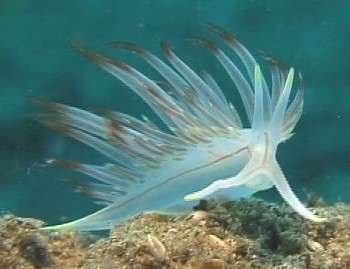
Here's another nudie I found in Milne Bay, Papua New Guinea, during mid March of this year. It was in coral rubble in about 40 feet of water, water temp 83 degrees Fahrenheit. At first glance I thought it was a Hermissenda crassicornis like the ones we find here in the Pacific Northwest, but that doesn't seem very likely.
Ray Izumi
izumirm@sprynet.com
Izumi, R., 2000 (May 12) Aeolid from Papua New Guinea. [Message in] Sea Slug Forum. Australian Museum, Sydney. Available from http://www.seaslugforum.net/find/2369Dear Ray,
The brown lines on the body seem pretty distinctive but it doesn't remind me of anything I can think of. Flabellina rubrolineata sometimes has red lines like this but it is quite a different colour. Your animal looks more like a glaucid, such as a species of Sakuraeolis, than a flabellinid but that's a bit of a guess.
Does anyone recognise this animal?.
Best wishes,
Bill Rudman.
